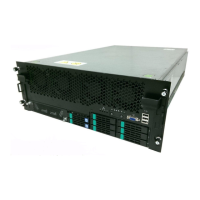For troubleshooting information see the Data Domain Support web site https://my.datadomain.com.
Troubleshooting Tips
If you purchased optional software for the Data Domain system such as
Replicator or Retention Lock, the licenses are enabled on your Data Domain
system prior to shipment. You need to configure them for use. Details on
configuring the optional software can be found in the DD OS Administration
Guide. Access the latest documents at
https://my.datadomain.com/US/en/platform.jsp.
Configure Optional Software
5
The Data Domain system provides multiple protocols for data access: NFS,CIFS,
VTL, and DD Boost. You need to configure one or more protocols for data
access, depending on your environment. You also need to configure the clients
for accessing the Data Domain system with the protocol of your choice.
NFS
The NFS configuration section in the configuration utility sets up the NFS
clients to allow access to /backup on the Data Domain system. You also need
to set up the NFS clients to allow access to /backup on the Data Domain
system. This can be done using the following steps:
4Create a mount point (directory) such as /dd/rstr01/backup and
create an administrative mount point such as /dd/rstr01/ddvar.
4NFS mount the directories on the new mount points. For example:
mount -F nfs -o hard,intr,vers=3,proto=tcp rstr01:/
backup /dd/rstr01/backup
mount -F nfs -o hard,intr,vers=3,proto=tcp rstr01:/
ddvar /dd/rstr01/ddvar
4Add the following lines to the file /etc/vfstab (the file name may be
different depending on your UNIX-based system). The lines mount the
directories at every reboot. For example:
system:/backup - /dd/rstr01/backup nfs - yes
hard,intr,vers=3,proto=tcp
system:/ddvar - /dd/rstr01/ddvar nfs - yes
hard,intr,vers=3,proto=tcp
4To cause backup software to abort when the system is not mounted,
create a backup directory within the mounted file system, such as
/dd/rstr01/backup/disk1.
4For more configuration information, see the specific Data Domain Integration
Documentation at https://my.datadomain.com/US/en/integration.jsp.
CIFS
The CIFS configuration section in the configuration utility sets up the CIFS
clients to allow access to /backup on the Data Domain system. You also
need to set up the CIFS clients to allow access to /backup on the Data
Domain system. For additional configuration information, see the specific
Data Domain Integration Documentation at
https://my.datadomain.com/US/en/integration.jsp.
DD BOOST FOR OPENSTORAGE OPTIONAL LICENSE REQUIRED
For setting up the Data Domain DD Boost feature, see the Data Domain Boost
for OpenStorage Administration Guide available at
https://my.datadomain.com/US/en/platform.jsp.
APPLICATION INTEGRATION
For information about how to integrate the Data Domain system with backup
software, see the documentation for the applicable application at the Data
Domain Integration Documentation section on the Data Domain Support web
site https://my.datadomain.com/US/en/integration.jsp.
Configure the System for Data Access
4
ADDITIONAL SYSTEM CONFIGURATION
Any system command that accepts a list, such as a list of IP addresses, accepts
entries separated by either commas or spaces. See the DD OS Commmand
Reference Guide for command details.
Give access to additional backup servers:
# nfs add /backup {*|client-list}
[options]
Add users to the email list that reports system problems:
# alerts notify-list add group-name
Add users to the system report email list:
# autosupport add {alert-summary|asup-detailed}
emails email-list
Enable FTP or TELNET:
# adminaccess enable {ftp|telnet}
Add remote hosts to use FTP or TELNET:
# adminaccess add {ftp|telnet}
fqdn-host-list
Add a user:
# user add name [role {admin|user}]
Change a user’s password:
# user change password username
Enable remote management:
Refer to the Administration Guide for details
TO SHUT DOWN THE SYSTEM
Important: Never shut down the system by pressing the power button.
Instead, use:
# system poweroff
Perform Optional Additional System Configuration
6

